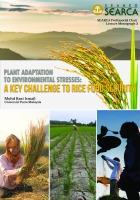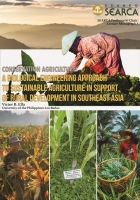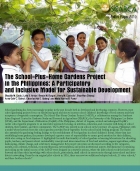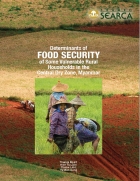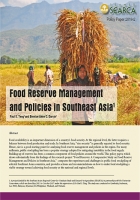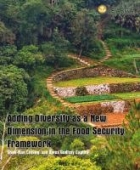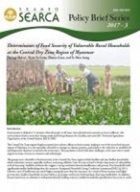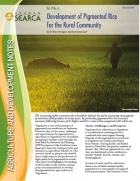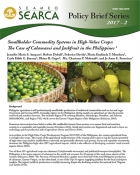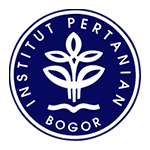SEARCA Publications
Plant Adaptation to Environmental Stresses: A Key Challenge to Rice Food Security
Dr. Mohd Razi Ismail
Environmental stress represents the most limiting factor to food productivity. Not only do they impact the crops being cultivated, but they also hinder other agricultural crops from being introduced for production to areas that are not currently being used for agriculture. One major problem in global agriculture is the significant fluctuations in annual crop yields due to the unpredictable and varying environmental stresses (e.g., drought, flooding, salinity, and high temperature)…
2019Regional Professorial Chair Lecture, No. 2
Conservation Agriculture: A Biological Engineering Approach to Sustainable Agriculture in Support of Rural Development in Southeast Asia
Victor B. Ella
This paper intends to provide comprehensive ideas and information about conservation agriculture as a biological engineering approach to sustainable food production in support of rural development in Southeast Asia. The basic principles of conservation agriculture, its advantages and benefits, its evolution, state of adoption in the world and in Southeast Asia, some recent advances in terms of experimental research in Southeast Asia, issues, constraints and challenges to its adoption, prospects…
2019Regional Professorial Chair Lecture, No. 1
The School-Plus-Home Gardens Project in the Philippines: A Participatory and Inclusive Model for Sustainable Development
Blesilda M. Calub, Leila S. Africa, Bessie M. Burgos, Henry M. Custodio, Shun-Nan Chiang, Anna Gale C. Vallez, Elson Ian Nyl E. Galang, and Maria Katrina R. Punto
In the Philippines, almost a third of 5-to 10 year-old children are underweight and stunted, and poor nutrition has led to poor academic performance and early school dropouts. Also, a major concern for the future of food security in the Southeast Asian region is the youth's declining interest in agriculture. To address these two problems, Southeast Asian Regional Center for Graduate Study and Research in Agriculture (SEARCA), in collaboration with the University of the Philippines Los Baños…
2019Agriculture and Development Notes, Vol. 9, No. 1
The School-Plus-Home Gardens Project in the Philippines: A Participatory and Inclusive Model for Sustainable Development
Blesilda M. Calub, Leila S. Africa, Bessie M. Burgos, Henry M. Custodio, Shun-Nan Chiang, Anna Gale C. Vallez, Elson Ian Nyl E. Galang, and Maria Katrina R. Punto
School gardening has been increasingly popular in the past decade both in developed and developing countries. However, most school gardening projects focus on educational goals and aim to increase school children's knowledge of food systems and their acceptance of vegetable consumption. The School-Plus-Home Gardens Project (S+HGP), a collaboration among the Southeast Asian Regional Center for Graduate Study and Research in Agriculture (SEARCA), the University of the Philippines Los Baños…
2019Policy Paper
Determinants of Food Security of Some Vulnerable Rural Households in the Central Dry Zone, Myanmar
Theingi Myint, Hnin Yu Lwin, Thuzar Linn, and Ye Mon Aung
The main objective of this study is to assess and analyze the food security status, coping strategies, and determinants of the most vulnerable groups in the Magway Region in the Central Dry Zone of Myanmar. A multistage sampling technique was used to select 208 respondents among smallholder farmers, landless, and female-headed households in four villages. The collected data were analyzed and discussed using descriptive statistics, inferential statistics, and logit…
2018Monograph
Food Reserve Management and Policies in Southeast Asia
Paul S. Teng and Bernice Anne C. Darvin
Food availability is an important dimension of a country’s food security. At the regional level, the latter requires a balance between food production and trade. In Southeast Asia, “rice security” is generally equated to food security. Hence, rice is a good starting point for analyzing food reserve management and policies in the region. For many millennia, public stockpiling has been a popular strategy adopted for mitigating instability in the food supply. Building up of reserves has been…
2018Policy Paper, No. 2
Adding Diversity as a New Dimension in the Food Security Framework
Shun-Nan Chiang and Xyrus Godfrey Capiña
International development is undergoing a paradigm shift from a focus on hunger to an increased focus on the coexistence of multiple forms of malnutrition. The comparison between the United Nations’ Millennium Development Goals (MDG) and the Sustainable Development Goals (SDG) embodies this paradigm shift. Published in 2000, MDG set the first goal as “eradicate extreme poverty and hunger.” Under this goal, one of the main targets is to reduce half of the proportion of people who…
2018Policy Note
Determinants of Food Security of Vulnerable Rural Households at the Central Dry Zone Region of Myanmar
Theingi Myint, Hnin Yu Lwin, Thuzar Linn, and Ye Mon Aung
Food security is defined as “a situation when all people, at all times, have physical and economic access to sufficient, safe, and nutritious food to meet their dietary needs and food preferences for a healthy and active life” (Food and Agriculture Organization of the United Nations [FAO] 1996).Myanmar’s Central Dry Zone region, with its fragile ecosystem is one of the most food insecure regions of the country. It is especially vulnerable to changes in climatic patterns, particularly to…
2018Policy Brief Series, Vol. 2017, No. 3
Development of Pigmented Rice for the Rural Community
Tri Rini Nuringtyas and Dyah Ismoyowati
The increasing public awareness for a healthier lifestyle has led to a growing consumption of nutritious food products in recent years. In particular, pigmented rice has created a consumer following because of its higher nutritive value when compared with white rice.
2018Agriculture and Development Notes, Vol. 8, No. 6
Smallholder Commodity Systems in High-Value Crops: The Case of Calamansi and Jackfruit in the Philippines
Jennifer Marie S. Amparo, Robert Dyball, Federico Davila, Maria Emilinda T. Mendoza, Carla Edith G. Jimena, Dhino B. Geges, Ma. Charisma T. Malenab, and Jo Anne E. Francisco
Philippine agriculture is still predominantly smallholder production of traditional commodities such as rice and sugar(Cororaton and Corong 2009). Ironically, regions in the Philippines relying mainly on agriculture are also the poorest, and food and nutrition insecure. This includes Region IVB covering Mindoro, Marinduque, Romblon, and Palawan (MIMAROPA), and Region VIII, which covers the Eastern Visayas Region of the Philippines (Balisacan 2003). Numerous interventions have failed to either…
2018Policy Brief, Vol. 2017, No. 2
